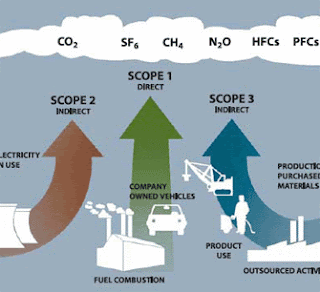The Kyoto Protocol set the six types of greenhouse gases, namely carbon dioxide (CO2), methane (CH4), nitrous oxide (N2O), and three industrial gases containing fluorine (HFCs, PFCs, and SF6). Carbon dioxide is 70 percent of the total volume of greenhouse gases this, followed by methane, nitrogen oxides, and so forth. Water vapor is a greenhouse gas is actually the most powerful. But because of his age in the atmosphere is only calculated a few days, then gl0balnya warming potential (global warming potential, GWP) is not too influential.
Carbon dioxide released by combustion of hydrocarbon materials such as fossil fuels (coal, petroleum, natural gas) or biomass (wood, etc..), By deforestation or forest degradation, or by the release of carbon below ground (sub-soil carbon) by destruction of peat land ecosystems. Forests absorb carbon dioxide in the atmosphere for photosynthesis needs. The fewer forests, the less carbon dioxide is absorbed, so the more carbon dioxide, which thicken the blanket of greenhouse gases in the atmosphere. Carbon dioxide in the atmosphere lived up to 80-120 years. However, its relatively low GWP. But because the amount at most, then the total potential is also great. Because the amount at most as well, then the carbon dioxide greenhouse gases are considered as reference, the GWP considered a single digit. GWP greenhouse gases other is the comparison with carbon dioxide.
Methane is released by decaying organic materials such as wood, municipal waste or agricultural / plantation, as well as by exhaust gas or feces living beings. Methane stay in the atmosphere for approximately 8 years, and has a GWP of 21 (that is, each molecule of methane has the potential to heat up the earth 21 times as much carbon dioxide molecules. It is a calculation with restrictions Periodof 100 years). Nitrogen oxide is usually a byproduct of the manufacture of nitrogen-based fertilizer, staying in the atmosphere up to XX years, with a GWP of 310. Industrial gases containing fluorine (HFCs, PFCs, and SF6) produced by industrial processes, and stay in the atmosphere almost in perpetuity because there is no absorbent or natural destruction. SF6 gas is usually used as an insulator in high voltage electrical network. Although the amount in the atmosphere is very very little, but the GWP of HFCs, PFCs, and SF6 is the most high, respectively 7.000, 12.200, and 22.000.
Carbon dioxide released by combustion of hydrocarbon materials such as fossil fuels (coal, petroleum, natural gas) or biomass (wood, etc..), By deforestation or forest degradation, or by the release of carbon below ground (sub-soil carbon) by destruction of peat land ecosystems. Forests absorb carbon dioxide in the atmosphere for photosynthesis needs. The fewer forests, the less carbon dioxide is absorbed, so the more carbon dioxide, which thicken the blanket of greenhouse gases in the atmosphere. Carbon dioxide in the atmosphere lived up to 80-120 years. However, its relatively low GWP. But because the amount at most, then the total potential is also great. Because the amount at most as well, then the carbon dioxide greenhouse gases are considered as reference, the GWP considered a single digit. GWP greenhouse gases other is the comparison with carbon dioxide.
Methane is released by decaying organic materials such as wood, municipal waste or agricultural / plantation, as well as by exhaust gas or feces living beings. Methane stay in the atmosphere for approximately 8 years, and has a GWP of 21 (that is, each molecule of methane has the potential to heat up the earth 21 times as much carbon dioxide molecules. It is a calculation with restrictions Periodof 100 years). Nitrogen oxide is usually a byproduct of the manufacture of nitrogen-based fertilizer, staying in the atmosphere up to XX years, with a GWP of 310. Industrial gases containing fluorine (HFCs, PFCs, and SF6) produced by industrial processes, and stay in the atmosphere almost in perpetuity because there is no absorbent or natural destruction. SF6 gas is usually used as an insulator in high voltage electrical network. Although the amount in the atmosphere is very very little, but the GWP of HFCs, PFCs, and SF6 is the most high, respectively 7.000, 12.200, and 22.000.




0 comments:
Post a Comment